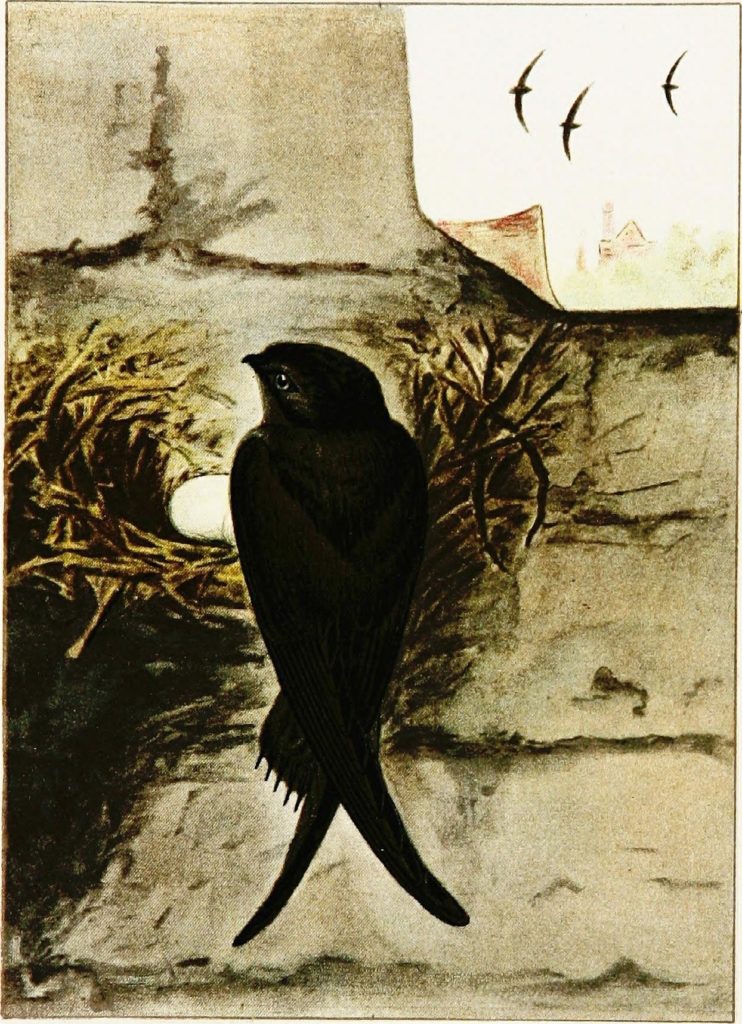Guided by the writings of Charles Foster, Sue Brooks’ consciousness fills with swifts.

Plate XXVIU – CHIMNEY SWIFT, taken from ‘Bird-life: a guide to the study of our common birds’ (1901). Via Cornell University Library / Internet Archive Book Images on Flickr.
It’s the fourth HOT day in a row and I will spend most of it in the house with all the windows and doors open. It’s slightly cooler that way. At 5pm I will drive the two miles to Machen Road because there’s an odds-on chance that they will be there again.
Yes, this is another swift story, which I have been putting off because there have been so many this year. But what the hell? Is “enough” a word to use about a swift? Never.
The Forest of Dean is not on the map, generally speaking, in the swift world. This is not Oxford, or Bristol or Cambridge or any other town/city with ancient buildings, yet a small colony has remained faithful to Machen Road. I have no idea why. What has this road, on a piecemeal estate of detached houses built in the 70s or 80s, got to offer a swift? Street parking, narrow gardens with high fences and, as far as I can see, all the roof spaces have been tightly sealed. Apparently nothing. But since 2016, this unlikely place has become a Mecca to me.
That was the year I read the swift chapter in Charles Foster’s Being A Beast. I loved that book. I loved the mind of the man who wrote ‘I want to know what it is like to be a wild thing’. You have to have a certain amount of wildness in you to say that, which he does — and by extension, so do I.
This is what can happen on Machen Road at the end of July. After feeding hundreds of feet up in the blue, small groups of six or seven will come down to street level and tear through the gaps between the houses. They’re not screaming, but the word describes what they do soundlessly. They favour the numbers 23 and 24. The only distinctive thing seems to be the amount of telegraph wires crossing that particular gap. Four pairs at different heights and angles to each other — a total of eight wires between a single pole and two houses. The swifts could be doing 40 mph, tightly packed as they loop around and behind and come to the gap again and again. Is there any way of understanding this apart from the sheer FUN — the power and the glory of it? They may be failed breeders or this year’s fledglings from further afield, checking out the territory and sealing it into their memory for when they return next year. Either way, they CHOOSE to fly there, and then, for one more night, please at least one more, climb thousands of feet into the heavens to sleep. This is what draws me to Machen Road, to find a parking place that doesn’t belong to anyone else, and stand on the pavement in 30 degrees Celsius and try to move my eyes at the speed of a swift.
It’s all intense. Having swifts in your consciousness is a serious business. Reading The Screaming Sky this year has a lot to do with that. I’m deeper into the mind of Charles Foster’s lifelong obsession, and it’s not a comfortable place to be. But who wants comfort?
‘The better we get at looking for consciousness’ he says, ‘the more we find it’. And one of the best ways is asking questions. What is it like to approach a nest hole at 45 mph and land on feet that have no rear claws? Do swifts have a memory of their partner when they have been absent for nine months? Particularly, Foster questions his own obsessive tendencies, his cravings, his dreams, the anthropomorphism of it all. He’s rigorous with this and outrageously funny. Here is one example, my favourite from a long list. It concerns the guts of newborn swifts. He has already told us that the tiny body is so full of guts that the cloaca, normally at the rear end, is pushed up onto the nestling’s back.
‘It looks so weak, and indeed swift nestlings can do little for a while other than open their mouths for food, jostle their siblings when another cropful of air-plankton arrives, and defecate skywards through their eccentric cloacas.’
(I’m slightly embarrassed to tell you that for many days, off and on, I have laughed with this sentence, and even dreamed about it. Who would not wish for an eccentric cloaca?)
The prose is muscular and fast-moving. There’s a lot of body in it, and science from the study in the attic of his Oxford home, but what I love most is the recklessness, the “what the hell?” aspect. As he puts it, ‘rakishness, dashingness and agility are in the eye of the beholder, and if I want to see them, just try to stop me’.
Well, exactly.
Which brings me to the most important reason for writing this piece. The Screaming Sky is on the longlist for the Wainwright Prize and the shortlist will be announced on August 4th. Some of the judges might be reading The Screaming Sky right now. Could morphic resonance play a part if enough of us feel the same?
I was right, amazingly, in my gut feeling for last year’s winner. Could it happen again? The shortlist is the next step. Will you join me?
*
You can peruse all the titles on the longlist for this year’s Wainwright Prize via our bookshop.org page.